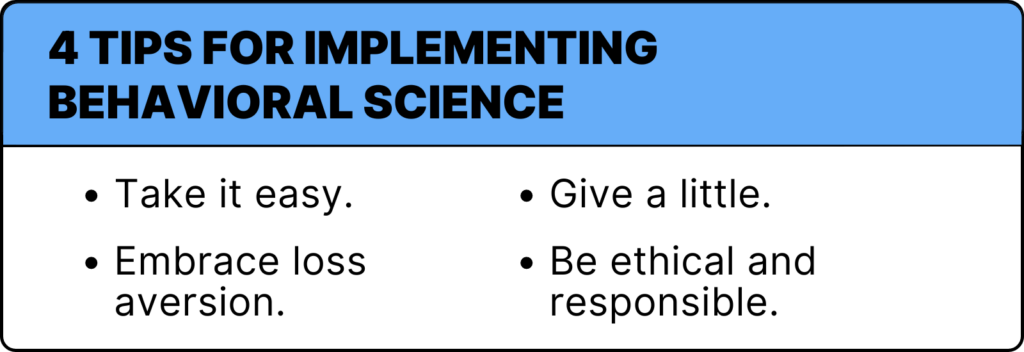We all fall down random rabbit holes occasionally (or maybe more often than that 🫣), but when’s the last time doing so changed the entire direction of your career?
Nancy Harhut was working in advertising when a colleague recommended she read “Influence: The Psychology of Persuasion” by Dr. Robert Cialdini. She devoured the text and discovered a new passion for behavioral science. From there, she began a quest to learn everything she could about the field and apply some of the lessons to her work.
Not so surprisingly, the behavioral science techniques Nancy was learning worked (more on that shortly!). She set off in a permanent new direction, marrying marketing best practices with behavioral science research, and she’s never looked back.
Today, Nancy is Co-Founder and Chief Creative Officer at HBT Marketing. She’s been experimenting with behavioral science in marketing for over a decade and even wrote her own book on the subject, “Using Behavioral Science in Marketing: Drive Customer Action and Loyalty by Prompting Instinctive Responses.”
What Is Behavioral Science?
Before we talk about how to use behavioral science in our work, let’s define it.
Nancy describes behavioral science as “the study of how people behave or, more specifically, why they do what they do. Scientists have found that people don’t often make decisions. Instead, we rely on decision-making shortcuts to conserve mental energy.”
These automatic, instinctive and reflexive shortcuts present a massive opportunity for marketers because if you know that people are likely to do Y when they see X, and you want them to do Y, you’ll know you need to show them X. You can proactively build it into your creative strategy to nudge people along.
Behavioral Science in Action: The Magnetic Middle
Nancy remembers one of her earliest examples of behavioral science application.
The stakes were high, as the agency she was working for was worried about losing one of their biggest accounts. Not only that, but the client’s line of business wasn’t all that…interesting, to put it mildly.
“The assignment was to sell life insurance to dentists,” Nancy recalls. “Very exciting, right? But it turned out to be very interesting because they’d already sold dentists policies, and now they wanted to get them to upgrade the policy. It’s really hard to sell life insurance to anyone! If you’re lucky enough to get people to make that decision, those people usually check it off their list and never look back.”
All of the standard sales tactics were failing. The clients contacted the dentists to ask them to reevaluate their policies based on business or family growth. No dice. Then, they tried to explain to the dentists that life insurance amounts should be assessed regularly to make sure you have the right amount. Still nothing.
Then, Nancy remembered a concept from Dr. Cialdini’s book: “the magnetic middle.” People don’t like to lag behind, but they also don’t like to be at the extreme forefront of something. People most like to be in the middle; it’s a safe, cozy place.
Nancy’s team put together a graph showing the least amount of insurance you could carry (read: none), as well as the most you could carry at that time ($3 million). Then, they visually marked on the graph where the specific dentist fell.
“There were quite a few dentists who had less than $1.5M, which was the center amount,” Nancy explains. “So at a glance, they saw themselves left of the center — lagging behind. We didn’t expect them to buy insurance to get all the way up to $3 million, but we did think they’d buy more to move to the middle.”
And that’s exactly what happened! The company experienced a 459% boost in business, and the agency got to keep its biggest client, all thanks to Nancy’s behavioral science experiment.

4 Behavioral Science Tips You Can Implement Now
Here are some tips you can put to work right away:
- Take it easy. Cognitive fluency refers to the fact that people prefer things that are easier to understand. That means we need to nix the acronyms, jargon, buzz phrases, and complicated vocabulary and opt for accessible, simple language. Research has shown that even highly educated audiences prefer this!
- Embrace loss aversion — a little goes a long way. We often focus on the benefits of our product or service, but behavioral scientists know that people are twice as motivated to avoid the pain of loss than to achieve the pleasure of gain. So, instead of saying, “Take advantage of our sale,” try, “Don’t miss this sale!” Or instead of, “Save today,” use, “Prices go up tomorrow.” These little language tweaks can make a big difference in creating a sense of urgency in your audience.
- Give a little. Reciprocity is hardwired into humans. When you give someone something or do something for them, they want to pay it back. This doesn’t have to mean expensive gifting strategies, either. Maybe you create how-to videos to help your current customers or send them a handy cheat sheet. Or, depending on your budget, perhaps you take it further and send your customers more bespoke gifts. The act of giving builds appreciation and trust, and it can lead to more business!
- Be ethical and responsible. Even as you try your hand at behavioral science, don’t lose sight of your brand integrity. Short wins are never worth it if they compromise the trust your audience has in you.
“I always tell people to treat your customers the way you want to be treated,” Nancy says. “Don’t say something to them that you wouldn’t say to your kids, your spouse, or your parents. Just be honest. If you can honestly say that your statements are true and you’re not asking anyone to take a harmful action, then you can properly deploy behavioral science.”






